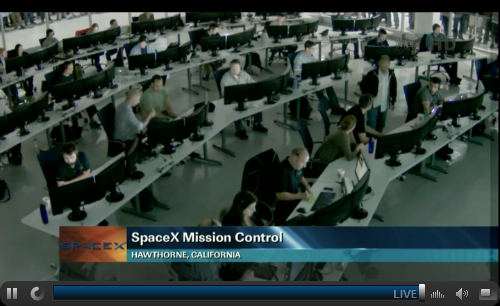The Dragon spacecraft of SpaceX corporation successfully splashed down after a successful overall mission of hauling cargo to and from the International Space Station.
It’s an incredible success for a commercial venture.
I also found the appearance of the SpaceX mission control facility revealing. Ordinary office desks, ordinary office chairs, ordinary flat screen monitors. Nothing special, no horrendously expensive custom hardware.
This reinforces my impression that the SpaceX venture actually brought the 21st century to NASA and the ISS. An impression that was created by the ISS crew’s reaction to the Dragon capsule’s “new car smell” and its space-age interior complete with smooth surfaces, blue LEDs and whatnot.
Congrats to SpaceX. Well done. Here is to the future.

Great comments, Viktor. I’m a docent at the National Air and Space Museum in Washington, DC. I specialize on the history of the CORONA surveillance satellite system. Here is a photo of a control console from the dawn of the U.S. space program. Note the pair of TV monitors – and how simple the entire control console was.
http://airandspace.si.edu/collections/artifact.cfm?id=A19940160000
The narrative reads:
Dimensions:
Overall: 3 ft. 4 in. tall x 9 ft. 7 in. wide x 3 ft. 4 in. deep (101.6 x 292.1 x 101.6cm)
Atlas-Agena Control Console
Materials: Knobs/switches: plastic and metal Overall: metal and green paint
This is part of the suite of consoles built by General Dynamics, Inc. and used to launch Atlas-Agena rockets from Vandenberg Air Force Base, California, in the 1970s and 1980s. The Atlas was developed as a liquid-fuel, intercontinental ballistic missile, and it also was used to launch four missions carrying Mercury astronauts into Earth orbit. The Atlas was also modified to carry an Agena upper stage, which carried a variety of payloads, including reconnaissance satellites, into orbit.
For missions that required a polar or near-polar orbit, the Vandenberg launch site was used, as it allowed a launch over water rather than over a populated area of land. These consoles were part of the equipment that served those launches.
Transferred from U.S. Air Force to NASM in 1994.